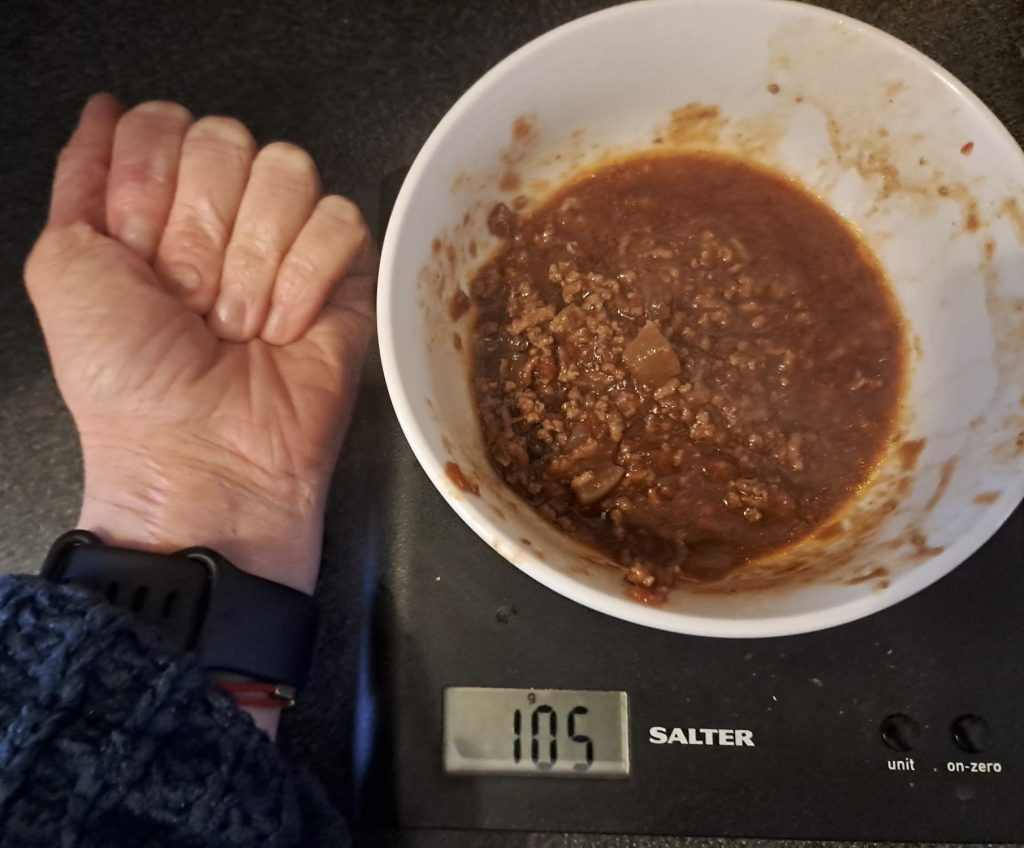Posted on December 28, 2023 by Emily Forbes
Ok, this is bit of a fake title. A while ago Kate wrote a blog on what 100g looks like [in veggies], and it has been our most popular blog. I was asked to write a meat edition and take photos; I only do my shopping once a week and there isn’t a different daily meat included in there. So, I did my best take on “what does 100g look like – meat edition”.
When I started my food prep this week I suddenly remembered about the blog I promised to write. I weighed out 100g of beef mince, except it was already made into bolognese by then so is not a 100% true representation. To put into context though, most packs of mince are 450g-500g. Divide it into 4 to make burgers and each burger is roughly 100g. The reason for trying to highlight what 100g looks like is because most tracking apps default to 100g measurement and does not necessarily represent a portion. For example a chicken breast is not 100g!

Let’s break it down:
So let’s compare what 100g contains in terms of protein and calories; with what an actual portion size contains.
- 100g mince (12% fat) = 20.3g protein & 190Kcals. I made a bolognese with 500g of mince which made 4 portions; the actual tracking for a 125g portion would be 25.4g protein & 238kcals (not including the veggies I put in).
- 100g chicken breast = 33.3g protein & 144kcals. A typical chicken breast actually weighs 175g per serving = 58.3g protein & 252kcals
- 100g ham [honey roast, medium sliced] = 22.3g protein & 117kcals; recommended portion 1 slice; depending on the thickness of the cut the typical portion size will be averaging 2-4 slices. 2 slices is around 100g!
- 100g salmon fillet = 23.4g protein & 178kcals; portion 110g = 25.8g & 196kcals
- 100g egg = one large egg weighs between 63-73g; portion 2x large eggs = 15.8g protein & 160kcals
What does it mean?
When we look at the numbers for portion size, we can see that a portion of meat packs a lot of protein and not too many calories. Protein is needed for so many functions in the body, not just muscle building but also DNA, cellular systems, immune system and hormones. If you were trying to lose weight (or any circumstance) you want to focus on high* protein intake. Protein helps satiety (feelings of fullness). You can also eat more for less calories. Combine protein with salad and veggies which will also help with satiety because of the fibre with less calories. I’ll produce another blog which will look at fats and carbohydrates which is where portion sizes will make a bigger difference to calorie count.
Final word:
My advice here is, if you are trying to reduce or even increase calories, do double check your portion sizes. I have a set of scales on the side and find it easy to weigh things out in the kitchen. I do this more so because I don’t like to waste food and I know what the right amount for me. For example, I always weigh my oats for porridge. I know for me 40g is the sweet spot.
*high protein = a minimum of 1.2g of protein per kg of body-weight. I would usually aim for 1.5-2g/kg BW.
Happy tracking.

